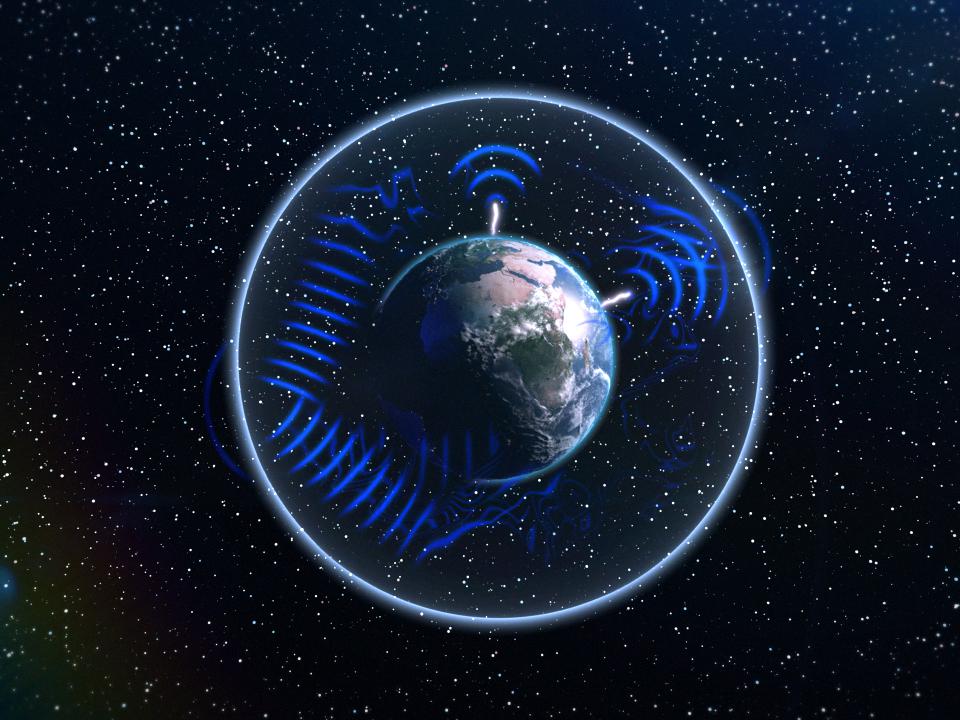LELAND MELVIN: We as a race, the human race, are intrinsically curious and we are wired in our DNA is that we are explorers. We look up at the night sky, we wonder what's up there, especially as children. And so this journey of exploring the things around us, whether they're close or far, that's what we do. That's what we do as humans.
BILL NYE: I meet a lot of people who want to go to Mars and make it like Earth. And I think people don't, first of all, don't grasp the scale of it. It's a planet. It's a whole planet. It's not, it's not a wetland that you can reclaim and build a parking garage on top of. It's a whole planet. Furthermore, this planet where you and I are from, is perfectly suited to us. We, our ancestors, and their ancestors and so on, grew up here tuned to these environments, to these climates that we have here on Earth.
And so people want to go to Mars in the spirit of adventure. It's a whole other thing to go to Mars, I tell people this all the time. There is nothing, there's hardly any water. There's a little bit. There is nothing to eat. There is no air! There's no air. 'Then we can build a bubble and you cook the Martian rocks and the oxygen out of them.' Okay. It's just not so easy and I say to everybody who thinks that they, well everybody, he or she who thinks he or she wants to colonize Mars: Go colonize Antarctica and see what you think. And don't, no no no, none of this going to the seashore where the penguins are swimming, and the orca are eating the seals, and there's krill for the very large whales. No, go to the dry valleys where it barely gets close to the freezing point of water. When there is water. It hasn't snowed or rained in a century. There's nothing to eat, and see what you think, really. See if that appeals to you.
STEPHEN PETRANEK: So the Martian soil can be anywhere from as little as 1% in some very dry desert-like areas to as much as 60% water. One strategy for getting water when you're on Mars is to break up the regolith, which would take something like a jackhammer because it's very cold. It's very frozen. If you can imagine making a frozen brick or a chunk of ice that's mostly soil and maybe half water and half soil, that's what you would be dealing with. So you would need to break this up, put it in an oven. As it heats up, it turns to steam, you run it through a distillation tube, and you have pure drinking water comes out the other end. There is a much easier way to get water on Mars. In this country, we have developed industrial dehumidifiers. And there's very simple machines that simply blow the air in a room or a building across a mineral called zeolite. Zeolite is very common on Earth, it's very common on Mars. And zeolite is kind of like a sponge. It absorbs water like crazy, takes the humidity right out of the air. Then you squeeze it and out comes the water. In many craters on Mars, there apparently are sheets of frozen water. So water is not nearly as significant a problem as it appears to be.
MELVIN: The food aspects. Eating food that not only tastes good, but it also has a nutritional value that you're going to get all the nutrients that you need to function and live for this extended period of time. The Martian environment is very harsh with the thin atmosphere, three-eighths G, solar radiation, all these things—building suits that can handle that when you're doing these excursions and going out and cleaning the solar panels, having robust systems that will keep you alive. Then water and food. I think I heard going to take 24,000 lbs of food for a colony of four or five to live up there. So do you pre-position, do you fly those and pre-position that there and hope that a dust storm or something doesn't wipe it out and know that it's still there? And then a shelf life of five years. Whereas the shelf life for the food on the Space Station is 18 months. So a five-year shelf life, and every time an item of food sits there for another month, another month, another month, it loses nutritional value, it loses flavor, it loses texture. So making sure that we have something that people will want to eat and will eat to stay healthy in this environment.
MICHELLE THALLER: Right now what I see is a really cool idea. It reminds me of a lot of my favorite science fiction stories, but it's basically just that: an idea. I think there's a long way to go before we actually see any significant colonization, any significant number of people going to Mars. First, we need to get one single person to Mars, or a small team of people, and that is something that is proven very very difficult. It's not so much a question that we can't build rockets to take us there because even today we have rockets that might have the capability of doing that. The problem is how you would keep a crew of people alive for the journey to Mars and then also alive on the surface and get them back. That would be very expensive, and because the astronauts would not be protected from the radiation of space, right now we really don't know how to keep them alive. It's not impossible. There's a lot of work that can be done. But when I see people thinking that SpaceX is almost ready to send people to Mars, that's where I have a bit of a wait-and-see attitude.
PETRANEK: The reason we need to travel to Mars and to establish a civilization on Mars is to protect the long-term survival of the human species. Eventually, the human species is going to disappear. That means everyone who is a human being will die eventually and this species will die out and go extinct. And there are a number of reasons how that could happen and why that could happen, including a large asteroid hits Earth and destroys everything larger than a rabbit. As happened in the age of the dinosaurs 65 million years ago. Or, eventually, our sun begins to die and that is a 100% probability. Our sun will begin to die in about 2 billion years and one of two things will happen. Either Earth will be thrown completely out of its orbit and go spinning off into space and everyone will die very quickly, or the sun will essentially irradiate Earth as it expands. Because what happens with a dying sun is it gets very large. And so in order to survive as a species, we have to become a spacefaring species. We have to get off this planet eventually, and that is the long-term hope for humanity. Mars is the most habitable place in our solar system by far, and even though it's an incredibly hostile environment, we've developed a technology over the last 50 years to survive on Mars and to survive quite readily.
THALLER: The astronauts on the Space Station are actually fairly well protected from radiation. The Earth has a liquid metal core, that generates a strong magnetic field around the Earth. Amazingly the Space Station, which is about 200 miles above us, is still in that protective magnetic field. So when you're just orbiting the Earth on the Space Station, the astronauts may get slightly higher doses of radiation, but they're actually fairly well protected. What happens if you go beyond the Earth's magnetic field though, is that all of a sudden you're vulnerable to the radiation of space.
PETRANEK: One of the defenses we will have against radiation on Mars is a spacesuit. A woman named Dava Newman has developed a space suit that looks more like something you would wear as exercise clothing in a gym. It's very tight fitting, kind of spandex like. It has metallic threads in it and it's fabulous at protecting you from radiation, at least in a short period of time. It also does another interesting thing which is, because the atmosphere on Mars is so thin, you would not explode and you would not have nitrogen narcosis like you do with the bends. But, you can't survive long on Mars because just walking outside if we forget about the radiation problem, because there's not enough pressure on your skin. On Earth, we have 15 lbs (14.7 lbs) of atmosphere piled up above us that presses on our skin at all times. And as human beings over a long period of time, we have evolved in our bodies to be pushing back. So underneath our skin essentially our bodies are pushing out at all times to compensate for that 15 lbs of atmospheric pressure. Now, you don't need 15 lbs of atmospheric pressure pushing on you to kind of keep you from turning into a balloon, but you do need about 5 or 6 lbs. A sort of spandexy space suit will create enough pressure against your skin. so that that problem is solved.
THALLER: We're working on technology and in some cases, it's a special kind of sleeping bag that you can get into and zip yourself up and have some protection. Other ideas, one of the best protectors against radiation is water. So if you have liquid water tanks on one side of your spacecraft, you might be able to shelter from the solar storm by putting the water tanks between you and the Sun. But if you're actually going to be living and working in space for a long time, this really is a problem. If we were to send astronauts to Mars for example, they wouldn't be protected from the radiation unless they could dig under the ground to build their habitats. Even just as much as 10 feet down would be enough, but that's hard. The Martian soil is very hard and rocky and not easy to dig through, and before you could go there you would have to send construction equipment to actually build all of these habitats.
We are observing some microorganisms that are very very good at protecting themselves from radiation. And one of them is my personal favorite animal. I have stuffed animal versions of this. It's a tiny, tiny, little microscopic animal called a water bear, or a tardigrade. And tardigrades are just little microscopic animals and they live on moss. All they do is suck nutrients off of moss, that's all they do. But a single tardigrade could take radiation levels that would kill a herd of 100 elephants. This tiny little animal is almost completely resistant to radiation, and its DNA works in a really cool way. Radiation breaks up DNA, that's one of the reasons you die when there's a lot of radiation around. And somehow tardigrades' DNA knows how to heal itself right back up. So we're studying how tardigrade DNA works in the hopes that maybe someday we could even repair radiation damage to human DNA.
MICHIO KAKU: Humans have to live in an environment where there's radiation; where there's loneliness; where the journey could take two years; where temperatures are below freezing; where the atmospheric pressure is only 1% the atmospheric pressure on the planet Earth. Eventually we want to create a base there. We're not going to go there just to plant a flag and come back and crow about it. No, we want a self-sustaining plant, a base on Mars that could support people. This means it has to be done in several steps.
The first step would be to create a base on Mars with power—solar power can provide the energy— and lava tubes. Underground lava tubes might be able to provide caves by which astronauts could live and create the first outpost underground. And then once you have the base setup, you have to begin the process of creating a self-sustaining agriculture there. I mean what are you going to eat on Mars? You can't order a hamburger because everything has to be shipped from the planet Earth. You want to create an agriculture, and this means genetic engineering. Then we have to create mining operations. We have the mine the ice. Ice can provide oxygen for breathing, water for drinking, and hydrogen for rocket fuel.
The last step in the process, and this will take maybe another hundred years, is to send satellites—satellites orbiting around Mars to begin the process of melting the polar ice caps. This is called space solar power. We have the blueprints already. The problem is cost, but the costs are dropping for sending payloads into outer space dramatically, and so people are once again dusting off these old plans to create satellites around Mars that can beam energy and begin the process of melting the ice caps. In 1966, the NASA budget consumed 5% of the entire federal budget. It was impossible to sustain that level of spending. Now it's about .5%. However, now with the injection of new ideas, fresh enthusiasm from the private sector, from Silicon Valley billionaires, we have a whole new different landscape.
NYE: So you can get humans in orbit around Mars without raising the NASA budget beyond letting it increase with inflation, which is an increase but not an extraordinary one. Furthermore, in order to pull this off without any increase in the NASA budget, everybody has to stick to these agreements that NASA will no longer be the lead funder or supporter of the International Space Station. That they're going to retire the Space Station or let commercial entities take it over. But if you did that really stuck to the agreements and you let the NASA budget increase with inflation, you could have humans were being Mars in 2033.
KAKU: To put me in orbit around the Earth costs about $10,000 a pound. That's my weight in gold. Think of my body made out of solid gold. That's what it takes me just to go around the Earth in near orbit. To go to the Moon would cost about $100,000 a pound. To put me on the Mars will cost at least a $1,000,000 a pound. That is unsustainable. And that's where the reusable rockets come in, because we're not talking about dropping the cost by a factor of 10. Instead of $10,000 a pound, SpaceX wants to bring it down to $1,000 a pound.
MELVIN: Exploration leads us to a better life. Heart pacemakers, smoke detectors, all these things have come out of the space program. But it's also not just the technological things, but it's the part that brings us together as a humanity. I was in space on my first mission with African American, Asian American, French, German, Russian, the first female commander. People we used to fight against were now breaking bread at 17,500 miles per hour, going around the planet every 90-minutes, seeing a sunrise and a sunset every 45, while breaking bread listening to Sade "Smooth Operator." Okay, that was surreal. That blew my mind and gave me this perspective shift when I looked back at the planet.
NYE: If we make this discovery of life, it will not have been done by an individual. By Galileo, or Copernicus, or Irene Curie. It would be done by a society who invested its intellect and treasure in this quest. Let's go see what's out there. Let's learn more about ourselves, our past, and we all want to know whether or not we're alone in the universe. So if we look on these two worlds, the Earth and Mars, and find life on both of them, that would suggest that life is very common in the cosmos. This would affect the way each and every one of us feels about what it means to be a living thing in the cosmos what it means to have this place in space.
MELVIN: So I think as a race of people, I think it's imperative that we continue to explore but also that we visit this neighbor that might have been like our planet at one time before. So this can be a harbinger of maybe things to come that we need to understand what happened there and what's going to potentially happen here on Earth. No matter what that time frame is, understanding that is very important.






